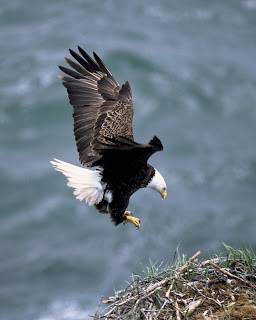 | Army Efforts Contribute to Removal of Bald Eagle from Endangered Species List. Jun 28, 2007, BY Robert DiMichele High Resolution Image ABERDEEN PROVING GROUND, Md. (Army News Service, June 28, 2007) - The U.S. Fish and Wildlife Service announced today the removal of the bald eagle from the list of threatened and endangered species. |
- Bald Eagles - Soaring Once Again
- Public Domain Footage of Bald Eagle
- Bald Eagle Delisting Ceremony Highlights
Army environmental stewardship efforts played an important role in bringing the bald eagle back from the brink of extinction, according to Michael Dette, chief of natural resources at the U.S. Army Environmental Command.
Fifty-eight Army installations report bald eagles living on or near its properties. In fact, the bald eagle has been the most common threatened or endangered species reported on Army installations.
The species rebounded in the last 40 years, largely due to the government's banning of DDT in 1972 and the protections provided by listing the bald eagles the Endangered Species Act. Based on the most recent population figures, the U.S. Fish and Wildlife Service estimates there are at least 9,789 nesting pairs of bald eagles in the contiguous United States.
"Removing the bald eagle, the symbol of our country, from the list of threatened and endangered species is a great environmental triumph. It provides a tangible example of how far our nation and its military have progressed as environmental stewards," said Col. Michael P. O'Keefe, commander of the U.S. Army Environmental Command.
Army installations apply a number of different natural resource-management practices to protect the bald eagle and its habitat, according to Mr. Dette. Typically, garrison staffs work to maintain and improve forested habitat for both breeding and non-breeding eagles, minimize human disturbance in nesting and wintering areas, maintain and improve the availability and quality of food supplies, and minimize direct hazards to bald eagles. Installations identify special management areas around eagle nests, and evaluate proposed activities within these areas for impacts on the bald eagle population.
For example, on some installations, forest management, harvest and thinning activities are limited to mid-July through mid-December to prevent disruptions to nesting eagles. Army forest-management practices, such as timber rotation and the retention of snags, also improve eagle-nesting habitat.
In addition, Army wildlife specialists pay special attention to the potential for electrocution or collisions with power or communication lines, installing deflectors, avoidance devices, insulators or perch guards where there is a risk to eagles.
"Bald eagles thrive on our installations because of decades of sound stewardship practiced by Army Soldiers and Civilians. This success story highlights just one of many innovative and diligent efforts going on every day to sustain our precious natural resources," Col. O'Keefe said.
The Army successfully protects more than 170 threatened and endangered species on its installations, to include the red cockaded woodpecker and the gray wolf. The Army and the U.S. Fish and Wildlife Service celebrated the recovery of the red cockaded woodpecker population on Fort Bragg last summer, five years ahead of schedule.
While the bald eagle has been removed from the list of threatened and endangered species, it will continue to be managed under both the Bald and Golden Eagle Protection Act and the Migratory Bird Treaty Act. On June 5, the U.S. Fish and Wildlife Service opened a 90-day public comment period on a proposal to create a permit program to authorize limited "take," or accidental killing or injury, of bald and golden eagles where the take is associated with, and not the purpose of, otherwise lawful activities.
When America formally adopted the bald eagle as the national symbol in 1782, as many as 100,000 nested in what would become the lower 48 states. By 1963, though, only 417 nesting pairs remained and the species was in danger of extinction. Loss of habitat, shooting for feathers and poisoning by the pesticide DDT all contributed to its near extinction.
(Robert DiMichele writes for the U.S. Army Environmental Command.)
Related Technorati Tags: Bald Eagle and Endangered Species List or U.S. Fish and Wildlife Servic and VIDEO, or MSU professors spearhead international water project or This Day in History Archduke Franz Ferdinand and Admiral Mike Mullen Biography











2 comments:
Good news for the eagles, good news for the satirists. :-)
Bald Eagle Now Boon For Homeless Chef
http://www.crystalair.com/content.php?id=35200707001
I got a nice McNabb jersey from sport-jerseys.biz.
Post a Comment